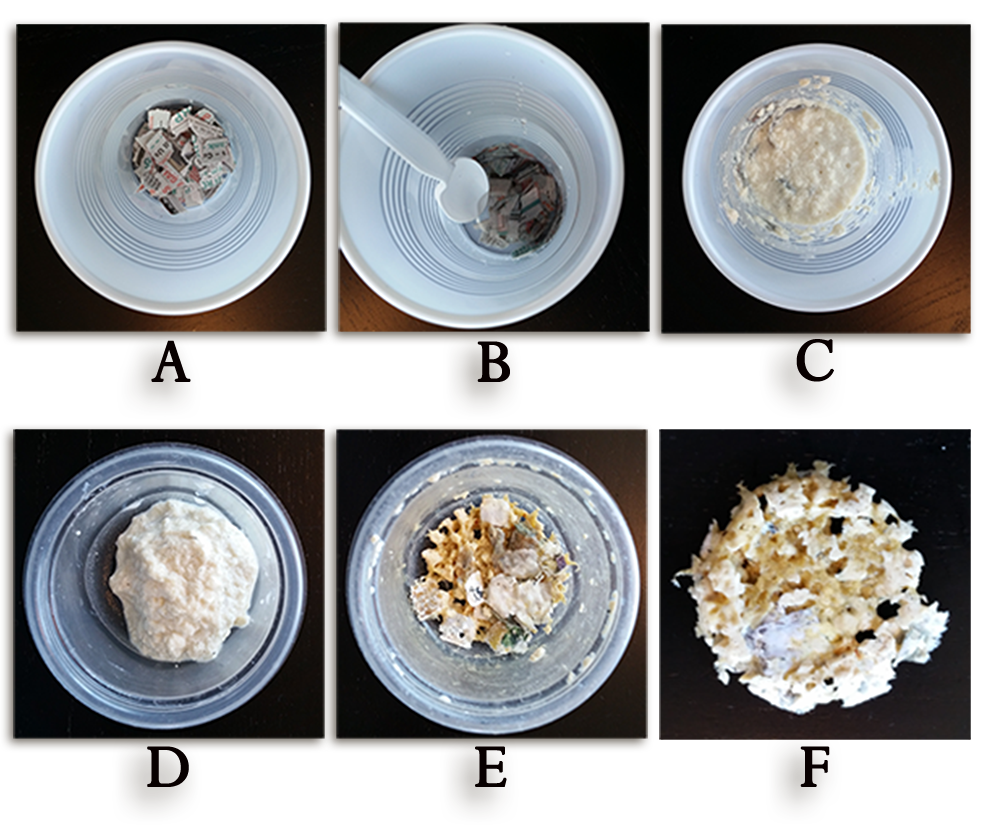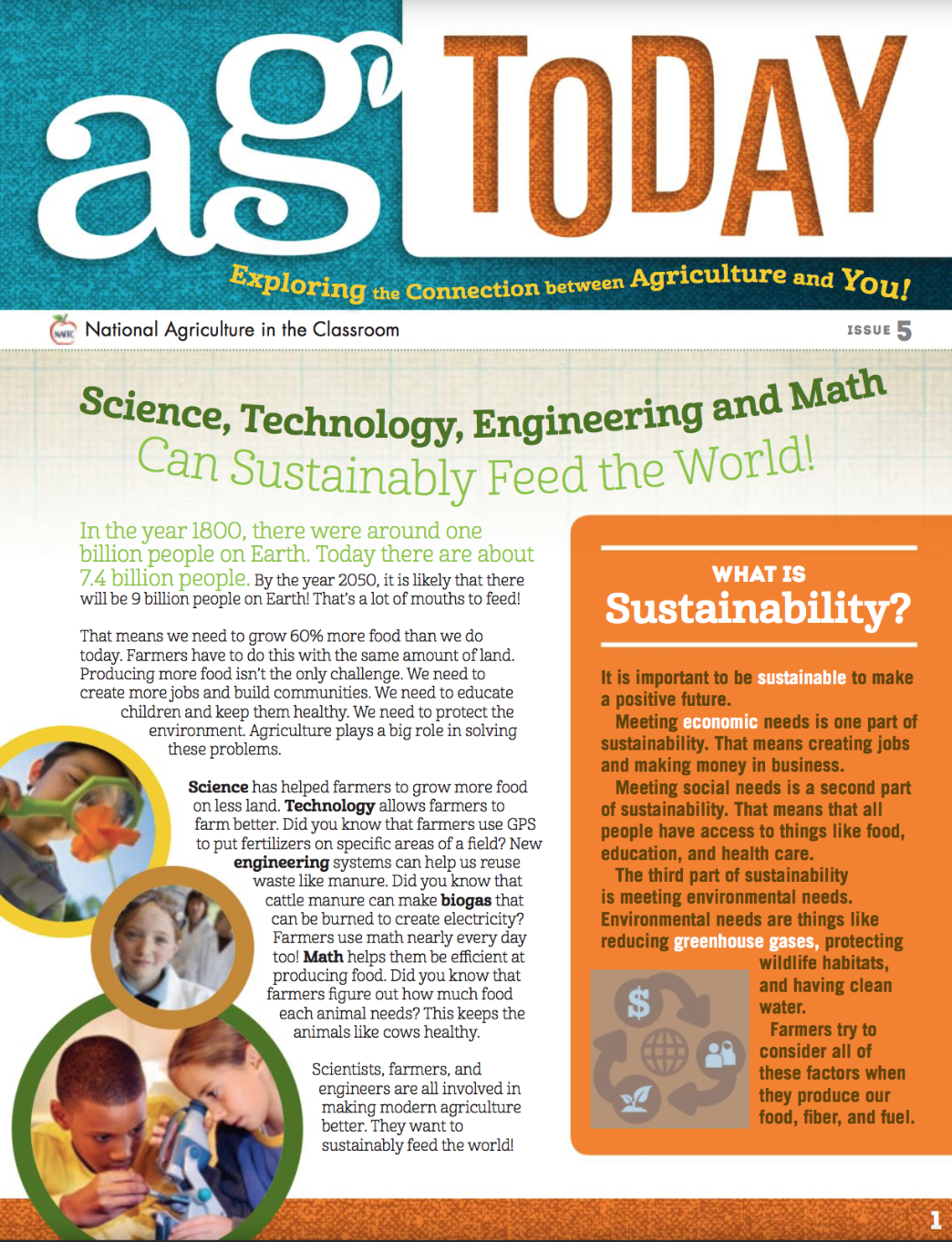Lesson Plan
From Soybeans to Car Parts
Grade Level
Purpose
Students investigate the collaborative work of an agricultural scientist and engineer who found new uses for soybeans and discuss careers in science and engineering, biobased products, and the use of renewable resources. Grades 3-5
Estimated Time
Materials Needed
Engage:
- 10-15 items from home or classroom (tools, kitchen utensils, school supplies, toys, etc.)
Activity:
- Soybean Ag Mag or Soybean Reader
- Interactive Map Project Soybean Map
- Background Information handout
- Newspaper - 4”x4” (10 cm x 10 cm) piece for each student or team
- Plastic cups
- Silken tofu
- Stir stick
- Microwave Oven
Vocabulary
bio-based : material or product derived from biological or renewable resources
coagulate: to change to a solid or semi-solid state
protein: an essential nutrient responsible for building tissue, cells, and muscle
tofu: coagulated soy protein made form soy milk
Did You Know?
- One acre of soybeans can produce 82,368 crayons.2
- The United States grows half of all the soybeans grown in the world.2
- Soybean products include: soy meal, soy flour, soy milk, tofu, soy sauce, infant formula, biodiesel fuel, and animal feed.3
Background Agricultural Connections
This lesson and activity allows students to create a biobased product. The term biobased can be defined as a material or product derived from biological or renewable resources. For an introductory lesson on the difference between renewable and non-renewable resources, see Activity 2 in the lesson, Corn An A-maizing Plant: Food, Fuel, and Plastic.
There are many items in our every day lives that are made from either renewable or non-renewable resources. Glass, various metals, plastics, and fuel are a few examples. Glass and metal are made from elements and minerals found naturally in the earth, however these are non-renewable resources due to the limitations we have in mining them from the earth's surface. Common plastics are made from petroleum, a fossil fuel which is also a non-renewable resource.
Science and technology has led to the development of various types of plastics and fuel which are renewable. Biodiesel made from vegetable oils, ethanol made from corn, and bioplastics are a few examples. Plastic is used to make countless items used in our everyday life. Plastic, made from soybeans, is even used in some car parts. These car parts are an example of a biobased product.
George Washington Carver was a scientist who was born to slave parents in Missouri during the Civil War. He worked as a farmhand in Kansas where he earned a high school education in his late 20s. Carver was the first black student to attend Iowa State Agricultural College where he earned a bachelor’s and master’s degree. He left Iowa and became an influential scientist at the Tuskegee Institute in Alabama. By convincing farmers in the South to plant peanuts as an alternative to cotton, Carver helped revitalize the area’s agriculture and became one of the most respected and influential scientists in the country. Carver is also known for his efforts in discovering that soybeans were a valuable source of protein and oil.
Like Carver, Henry Ford had an interest in soil science and the potential of alternative crops like peanuts and soybeans to produce plastics, paint, fuel, and other products. In 1942 Ford showcased a car with a lightweight plastic body made from soybeans. His motivation to build this car came from a shortage of metal, his belief that the plastic panels would make it safer than a steel car in an accident, and a desire to combine the fruits of industry and agriculture.1
Ford and Carver corresponded via letter in the early 1930s and developed a deep respect for each other that led to collaborative efforts in scientific and technological advancement for the agriculture and automobile industries.
In this lesson, students will heat the soybean protein found in tofu. This heating process causes the protein in the tofu to coagulate and change from a solid to a semi-solid. Students can analyze the product and develop ideas for how it could be used.
Engage
- Collect 10-15 items from around your home or classroom. Examples: tools (jammer, screwdriver, pliers, etc.) kitchen utensils (fork, spoon, cup, spatula, pizza cutter, etc.), school supplies (pencil, ruler, scissors, eraser, etc.), toys (stuffed animals, cars, etc.) Display the items to the students and ask them to brainstorm ideas for things they could make from the items you have collected. Could they make a musical instrument, trap for insects/pests, a shelter, something they can spin, etc?
- Praise the students for their creative thinking. Inform the students that scientists and engineers must be creative. They are constantly thinking of new ways to improve the things that we need to survive or make our life easier. Many times they try to develop uses for products that are renewable resources – like plants. (If needed, explain the difference between renewable and non-renewable resources)
- Ask students to list as many uses as they can think of for plants. Make a list on the board. When the list is complete, add "to make plastic" to the list. Ask your students if they knew that plastic can be made from plants. Inform your students that they will be learning about how science has been used to make farm products (like soybeans) more useful.
Explore and Explain
- Introduce soybeans to your class. Depending on their background knowledge, provide one of the following resources for your class to help them learn about soybeans, what they are used for, and where they are typically grown.
- Soybean Ag Mag: "Ag Mags" are magazines designed for kids.
- Soybean Reader: This 4-page reader contains information about soybeans. It can be printed and used for group or individual reading time.
- Visit the Interactive Map Project website and view the Soybean Map. Identify the top soybean producing states. Then, find your state and see how many soybeans are grown there each year. (Note: Some states do not produce soybeans.)
- Share with students, or have them research, the source of many plastics that we use. Many are created from petroleum products that are not renewable.
- Read the Background Information handout. Students can read on their own, as a small group, or as a class. Ask students the following reading comprehension questions:
- How did George Washington Carver and Henry Ford work together to make car parts using soybeans?
- How were these two men and their team of scientists creative?
- How are scientists and engineers still working together to invent new products that use living things (biobased products)?
- Inform students that you are going to show them how to make a form of plastic from tofu. Tofu is made by coagulating soy milk and pressing the curds into blocks.
- Model the following steps to create a bio-based product.
- Tear a 4”x 4” piece of newspaper into small pieces (preferably smaller than a dime) and place in a plastic cup.
- Add water until the newspaper is soaked. Stir the mixture so a slurry forms.
- Add 2 tablespoons of silken tofu to the slurry and mix until a consistent mass is formed. Add more tofu if needed for consistency.
- Remove mass from cup and squeeze out extra water. Shape into a ball.
- Place in microwave oven and cook on high for 10 minutes. Check to see if the ball is hard. If not continue cooking and checking in increments of 3 minutes.
- Remove ball from cup and cool.

- Allow students to follow the procedure for creating their own biobased product. Answer questions and assist where needed.
- Allow students to examine their biobased product. Ask the students:
- How could this product be used?
- How does the product you made compare to how George Washington Carver and Henry Ford used biobased products in the automobile industry?
Elaborate
-
View the video Farm to Car to explore the ways in which Ford Motor Company is continuing Henry Ford's legacy by using plant-based plastics in their products.
-
Visit the Interactive Map website and view the Soybean map. Discover what states produce the most soybeans. Does your state produce soybeans?
-
Investigate and research engineering careers related to the agricultural and automotive industries.
-
Invite a local soybean producer to visit your classroom and share information about growing and raising crops for food and other uses.
-
 Read Issue 5 of Ag Today titled Agriculture in Society. This reader can be accessed digitally. Students will learn the term sustainability and what that means to farmers who need to produce 60% more food with the same amount of land in order to feed a growing world population. Learn what byproducts are and how they are used, how food packaging has decreased waste, and how farmers use technology such as various tools, robots, and hand-held devices to improve their efficiency.
Read Issue 5 of Ag Today titled Agriculture in Society. This reader can be accessed digitally. Students will learn the term sustainability and what that means to farmers who need to produce 60% more food with the same amount of land in order to feed a growing world population. Learn what byproducts are and how they are used, how food packaging has decreased waste, and how farmers use technology such as various tools, robots, and hand-held devices to improve their efficiency.
Evaluate
After conducting these activities, review and summarize the following key concepts:
- Science is used to make farming more versatile and able to meet our needs. Science is used in the development of a method for making plastic out of soybeans.
- Renewable resources are valuable in preserving our natural resources for the future.
- Soybeans are an example of a renewable resource. Farmers grow soybeans which can be used to make plastic instead of using petroleum, which is a non-renewable resource.
Sources
- https://www.thehenryford.org/research/soybeancar.aspx
- http://farmflavor.com/soybean-fun-facts/
- http://ncsoy.org/media-resources/uses-of-soybeans/
Acknowledgements
Adapted from 4-H Agri-Science Curriculum, Robert L. Horton PhD Ohio State University Extension.
Recommended Companion Resources
- A Picture Book of George Washington Carver
- A Weed Is a Flower: The Life of George Washington Carver
- Adventures in Agriculture Coloring Book
- Ag Today
- Engineering Everywhere: Bioplastics
- Field to Film Career Snapshots
- Full of Beans: Henry Ford Grows a Car
- George Washington Carver for Kids: His Life and Discoveries, with 21 Activities
- George Washington Carver: Agriculture Pioneer
- George Washington Carver: Ingenious Inventor
- Grains and Legumes of the World
- My Family's Farm Book Series
- My Family's Soybean Farm
- Oilseeds Flowchart
- Packing Peanuts
- Planet Zorcon
- The Little Plant Doctor: A Story About George Washington Carver
- The Secret Garden of George Washington Carver
- The Things You'll Grow: Agriculture Careers for Little Big Dreamers
Author
Organization
| We welcome your feedback! If you have a question about this lesson or would like to report a broken link, please send us an email. If you have used this lesson and are willing to share your experience, we will provide you with a coupon code for 10% off your next purchase at AgClassroomStore. |